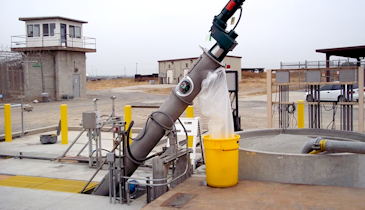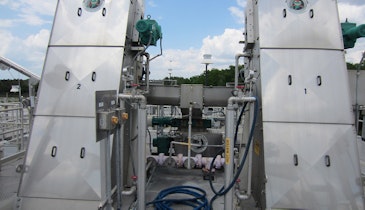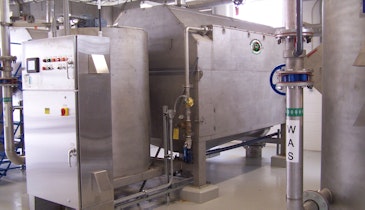
When designing a sludge thickening system, there are many considerations to account for, polymer chemistry being chief among them. The right polymer chemistry contributes to more effective thickening at a lower cost. However, the right chemistry must also be complemented by mechanical processes that empower the chemistry to work effectively.
With this in mind, waste treatment equipment manufacturer JWC Environmental collaborated with polymer suppliers for extensive lab trials to design a waste-activated sludge (WAS) thickening system for the city of Brockville, a community of more than 23,000 people located in southeast Ontario, Canada.
The Monster Drum Thickener system from JWC is capable of thickening 5.25 I/second of 0.55% municipal sludge to up to 7% solids. The collaboration resulted in a cost-effective sludge thickening system that operates in just one eight-hour shift. "It runs so well and is so user-friendly that an operator can start the system and leave when his shift ends at 3:30 p.m., and the system will shut itself off at 6 that evening," says Ed Malcomnson, supervisor of wastewater systems for the city of Brockville.
Background
Brockville was undergoing an upgrade to a secondary treatment system to meet more stringent effluent limits established by Ontario's Ministry of Environment including:
|
|
Previous Effluent Limits |
New Effluent Limits |
|
5-day Biochemical Oxygen Demand (BOD5) |
35.0 mg/L |
25.0 mg/L |
|
Suspended Solids |
45.0 mg/L |
25.0 mg/L |
|
Total Phosphorous (P) |
1.0 mg/L |
1.0 mg/L |
The city operated two digesters with a combined capacity of approximately 100 cubic meters of primary sludge per day, and the city averaged 40 to 50 cubic meters daily. However, achieving the new limits also increased sludge volumes, which created a need for additional digester capacity. The city was faced with a decision: either build another $2.9 million digester or add two rotary drum thickeners for less than $1 million.
Like many smaller municipal waste treatment systems serving fewer than 25,000 people, the city of Brockville required a WAS thickening system that was not only cost-effective, but able to adapt to continually fluctuating conditions. Malcomnson researched the city’s options and spent time consulting with other treatment facilities that use centrifuge technology in Ontario and North America. Ultimately, he decided the JWC IFT rotary drum thickening system met the facility’s needs and offered an economical solution for the city of Brockville.
Challenge: Unlike larger municipal waste treatment plants, which tend to experience steady biological conditions and more consistent average WAS concentrations, Brockville had wide variations in both — a common situation for smaller municipal waste treatment systems. Additionally, the initial design specified 100 pounds per hour solids throughput; however, operating conditions went up to 200 pounds per hour, resulting in a post-installation change.
Solution: JWC recommended two rotary Monster Drum Thickeners for their low-maintenance, easily removable wedgewire or mesh panels, and for their adaptive controls to compensate for fluctuation in sludge concentration and flow. In meeting the new effluent requirements, Malcomnson's team estimated an additional 20 to 30 cubic meters of primary sludge and another 200 to 250 cubic meters of secondary sludge per day. However, since secondary sludge is much thinner — 0.5% compared to primary sludge, which is 3 to 45% — the rotary drum thickeners converted the 200 cubic meters of secondary sludge into 20 cubic meters of 5% thickened waste activated sludge. As a result, less water is sent to the digesters. Although the digesters are handling an additional 40 to 50 cubic meters of primary and secondary sludge, they remain within their capacity. Because of the system's flexibility, the post-installation design change was easily accommodated and did not affect project costs.
.jpeg)
Getting the right chemistry
A WAS thickening system must be designed with the interdependencies of the entire process in mind, including chemistry, agitation speed and time, and screen size. Chemistries must be optimized from the start to enable effective thickening at lowest costs. Dosing systems and the mixing process must also be optimized to induce thickening and ensure high throughput.
“Our system is adaptable to allow higher throughput because we feed the sludge into the screens in a proprietary pattern that separates the water more quickly than other similar WAS thickening systems,” says JWC’s Bert Irwin. “The unique pattern allows us to treat lower concentrations at higher flows.”
Irwin worked with the Brockville engineers to optimize the polymer system so that it would reduce chemical costs. "Polymer selection is critical," Irwin says. "When you find the right polymer, the thickening process is much more economical and effective." Irwin explained that it can take up to a month to get the polymer right because the bacteria tends to change after about a month of operation, which affects flow rates and overall system performance. Polymer suppliers offer blends of their primary formulations in order to cover the full range of complex biological structures. Each WAS must be tested individually to obtain the best polymer selection, which can take a significant amount of time.
The team leveraged JWC’s extensive database of more than 50 similar installations and streamlined the polymer selection process. Thanks to JWC’s installation database, they quickly arrived at the most effective starting polymer without compromising project milestones. “Our installations represent nearly all the major biological treatment methodologies used in wastewater treatment plants where sludge thickening systems are applied,” Irwin says. He also worked with the polymer supplier to put in controls that would match changing conditions and prevent additional maintenance-related labor costs.
Optimizing existing systems
With the addition of the two JWC Monster Drum Thickeners for WAS thickening, the treatment plant successfully met the city's effluent limits without replacing its two existing digesters. For Brockville, that represented a significant cost avoidance of more than $2 million compared to building another digester.
The new WAS thickening system also optimized the city's waste treatment plant footprint. Each rotary drum unit is enclosed and contains its own air removal equipment, which eliminates odor and the need to build a special facility to house the equipment. This not only saves the city from spending valuable resources, but also eradicates odor pollution.
Long term, Malcomnson is confident the system will continue to keep costs in check as the new WAS thickeners require minimal maintenance and can run unmanned.
"Other treatment systems would have required us to run multiple shifts, but with the system's automation, we only run one eight-hour shift," says Malcomnson. He explains that the city has an operator on call in the event of any possible issues with the system, but they have yet to call him in.
"We have a lot of equipment to maintain, and a few pieces stand out as working well and being easy to operate and maintain. The JWC WAS thickening system is definitely one of those pieces."
For more information on the IFT rotary drum sludge thickening system, visit www.jwce.com.




